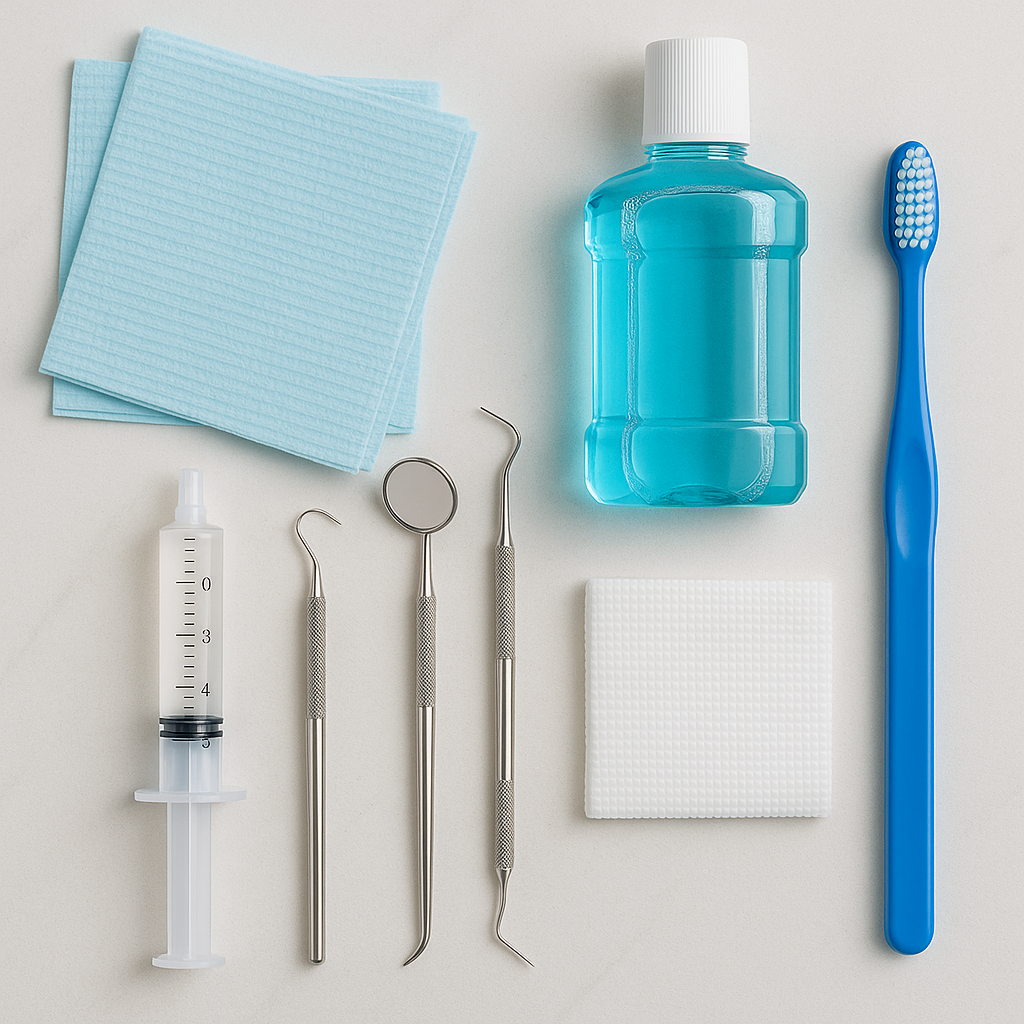Whether you’re sourcing materials for your practice or simply curious about a procedure you’re preparing for as a patient, you might be wondering - what is dental alginate made of? You’ve come to the right place.
This common material is primarily composed of sodium alginate, calcium sulfate, and retarders that ensure its malleability and quick setting time.
It’s predominantly used for capturing dental impressions given its ability to replicate fine details of the patient’s mouth with unparalleled precision. This allows you to rest assured you won’t have to waste time or resources making another impression.
From crowns to bridges, orthodontic appliances, and more - accuracy cannot be compromised in your impression process. Settling for less than the best materials is not an option.
So, set yourself up for success with our dental alginate here at My DDS Supply, the industry’s trusted choice for high-quality solutions at low prices backed by exceptional customer service!
What is Dental Alginate Made Of?
Let’s take a deeper look at the materials behind the impression - what is dental alginate made of?
The primary ingredient is sodium alginate, which is derived from seaweed. This natural polysaccharide is known for its ability to gel when combined with water, making it an ideal substance for dental applications.
It also features calcium sulfate, which acts as a setting agent. The reaction between calcium sulfate and sodium alginate forms a gel-like substance that hardens quickly to form the impression mold.
Trisodium phosphate is added as a retarder to control the setting time, allowing dental professionals sufficient time to work with the material before it solidifies.
These are the primary components. But sometimes you’ll find that dental alginate also contains fillers such as diatomaceous earth or silica, which contribute to the material’s strength and flexibility.
Meanwhile, flavoring agents and colorants are often added to improve the patient experience, making the impression process more pleasant.
The process of manufacturing dental alginate involves careful mixing of these components under controlled conditions to ensure consistency and reliability in every batch.
Common Uses
Now, what is alginate used for in dentistry? As we said from the start, this impression-taking material is used across a wide variety of applications, including but not limited to:
- Dental Impressions for Diagnostic Models: These impressions serve as a critical tool for diagnostic purposes, allowing dentists to plan treatments such as orthodontics, restorative work, and other dental procedures.
- Custom Mouthguards and Whitening Trays: Whether for sports mouthguards, night guards for bruxism (teeth grinding), or trays for teeth whitening treatments, the precise fit obtained from alginate molds ensures effectiveness and comfort for the patient.
- Temporary Crowns and Bridges: As discussed in our guide on how to make a temporary crown, the accuracy of alginate impressions ensures that these provisional restorations fit well, protecting the tooth and maintaining aesthetics until the permanent restorations are ready.
- Orthodontic Appliances: Orthodontists rely on accurate impressions to design and fabricate various orthodontic appliances like retainers and aligners. There is no room for error here, which is why alginate is the material of choice.
Tips on Making Your Own Dental Alginate Impressions
Unfortunately, we see so many new and seasoned professionals alike making a few common dental alginate impression errors. So, let’s quickly go over the process of using this material to leave you feeling confident making impressions with it:
- Proper Mixing: Use the manufacturer’s recommended ratio of powder to water and mix vigorously to avoid lumps, which can lead to inaccuracies in your impression. A smooth, homogenous mix captures the finest details of the oral structure. Our dental mixing tips can help streamline this process.
- Timely Application: Alginate sets quickly, so apply the alginate to the impression tray and then to the patient's mouth immediately after mixing it. Delay can cause the material to start setting before application, compromising the quality of the impression.
- Correct Tray Selection: Use a dental impression tray that comfortably fits the patient's dental arch. It should be large enough to cover all the teeth and gum areas without causing discomfort. Proper fit prevents the alginate from slipping or distorting, which could lead to flawed results.
- Adequate Material: Sufficiently filling the tray with alginate prevents thin spots that can tear when removing the tray from the mouth. It also prevents voids and drags in the final impression.
- Patient Preparation: Instruct the patient to breathe normally through their nose. Ask them to avoid movements such as tongue thrusting or swallowing, which can distort the alginate as it sets. Remember that they’re going through a pretty uncomfortable experience, so be patient with them and work diligently to minimize their discomfort.
- Proper Removal Technique: Once the alginate has set (check the setting time recommended by the manufacturer), remove the impression tray with a quick, steady pull. The goal is to prevent the alginate from stretching and distorting the captured impression.
- Storage and Handling: After removal, rinse the impression under cold water to remove saliva and debris. Store it in a sealed bag to prevent drying out. Alginate impressions should be poured as soon as possible with a suitable dental stone to prevent dimensional changes.
While it’s a fairly straightforward process, the margin for error is slim to none. That’s why starting with top-notch dental alginate is an essential first step.
Invest in Better Patient Outcomes and Productivity With Our Dental Alginate Impression Material!
Now that you know all about what dental alginate is made from and how to use it to create accurate impressions every time, there’s just one thing left to do - source the highest quality materials online today at My DDS Supply.
Designed for ultimate precision, our alginate formula offers exceptional detail accuracy for flawless dental restorations. It’s available in convenient sizes from 1lb to 6lbs and competitively priced, so every practice can find the perfect fit for its needs without stressing about budget.
Choose from our standard set with a swift 30-second mix time and a 3-minute set, or opt for our fast set that works in just 2:30 minutes, enhancing practice turnover without sacrificing quality.
Our alginate's color-changing feature supports precise timing, while its dust-free composition guarantees a clean working environment. Its superior elasticity and tear resistance minimize the need for retakes, saving valuable time and resources.
All of this is topped off with a refreshing mint flavor to improve the patient experience during impressions. With world-class customer service every step of the way, what more could you ask for?
Final Thoughts on What Dental Alginate is Made Of
So, what is dental alginate made from? We hope this resource has offered you clarity on the materials and inputs that go into these impressions - from the role of seaweed-derived alginic acid to the calcium sulfate, and other retarders that ensure its setting properties.
Each ingredient is crucial for creating impressions that are not only precise but also patient-friendly. Here at My DDS Supply, we’ve curated a collection that you can count on for all your impressions.
Our blog has additional resources like what is temporary crown made of, how strong is dental cement, how to soften dental putty, how long does dental cement last, how to make dental putty at home, and more.
But whether you’re looking for the various dental sterilization pouches sizes, the different types of dental burs, or any other material/instrument, remember that My DDS Supply is your trusted source.
If you’re interested in alginate, you may also want to learn more about our bite registration material, temporary crown material, VPS impression material, or temporary dental cement.
So, source materials and tools from the most trusted choice in the US dental industry online today. Equip your practice with the best, you and your patients deserve nothing less!

